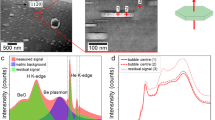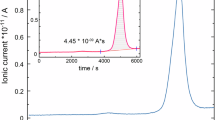Abstract
IT has been shown by Paneth and his co-workers in Berlin that any element which stands in the periodic table from one to four places before a noble gas will form an easily volatile hydride; such is the case with lead and bismuth, the hydrides being gaseous at ordinary temperatures. If, as is generally supposed, orthohelium has one electron relatively far removed from the nucleus with respect to the other, it is possible that in this state the helium atom might exhibit properties similar to, though less pronounced than, those of hydrogen; that is, it might be expected to combine with such an element as bismuth, and the resulting compound would in all probability be a gas.
Similar content being viewed by others
Article PDF
Author information
Authors and Affiliations
Rights and permissions
About this article
Cite this article
MORRISON, D. Helium Compound. Nature 120, 224 (1927). https://doi.org/10.1038/120224b0
Issue date:
DOI: https://doi.org/10.1038/120224b0



